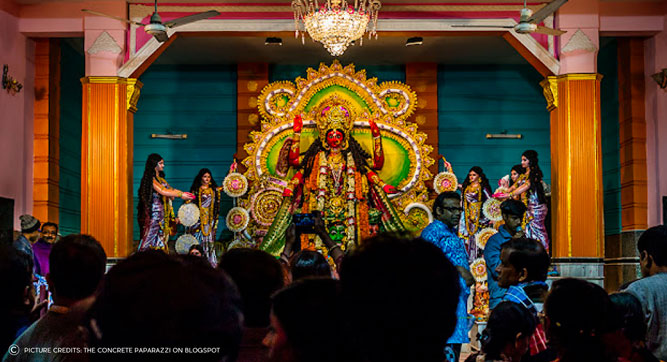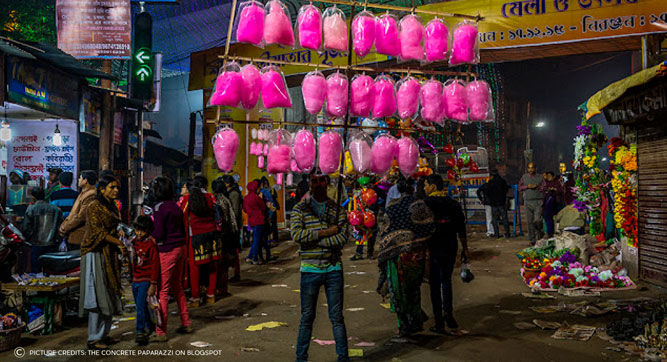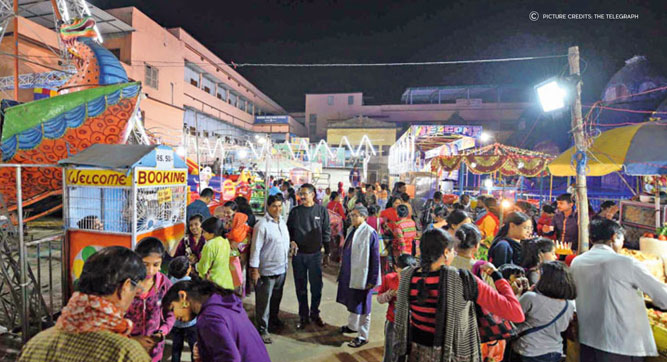BlogsAll about beautiful living
- Categories
Heritage cultural events along the Joka to Taratala Metro route

December 4, 5 and 6, 2022 saw another set of Saptami, Ashtami and Navami respectively being celebrated: Behala’s 230 year-old Chandi Puja & Mela took place.
People in Barisha traditionally worshipped Goddess Chandi and sought her blessings for the safety and happiness of their families. However, this ritual turned into an annual event when zamindar Mahesh Chandra Roy Chowdhury found a big brass pitcher in a pond while bathing, and brought it home.
A couple of days later, Goddess Chandi appeared in his dream and instructed him to initiate Chandi Pujo in his house. The year was 1792. The family installed the brass pitcher and began worshipping it. It remains at the same spot and is worshipped daily in the house now known as Chandi Bari as a symbol of the goddess.

The fair was started by Mahesh Chandra Roy Chowdhury as a form of entertainment for his subjects. The fairground surrounded the temple where the deity is worshipped. A strong police contingent stays posted around the temple on the puja days as the goddess is decked up with real jewellery.
Unlike other fairs, Chandi Mela doesn’t have a designated open space. It is mainly held in a residential area, spilling over to narrow roads and lanes, which make for a unique setting. The place remains abuzz with people pouring in from different parts of the city, giving you a feel of a rural fair in the middle of a bustling metropolis. In terms of footfall it can rival any top Durga puja in the neighbourhood!

The puja turned sarbojonin (community event) after the abolition of the zamindari system in the 1950s. The membership of the organising committee is no longer restricted to the Sabarna Roy Chowdhury family. It has several residents of the area and a few eminent Calcuttans, too.
Items on offer at the fair have changed with time — from wooden dolls that were a top-draw among kids about 50 years ago to mechanised and automated toys that attract children today. At the same time, some traditions have survived. Tarja-gaan, a folk tradition of Bengal, is performed on the day of immersion and it is still a top draw. Rendition of songs by popular artistes is another tradition that has lived.
In the past, this fair used to have a circus and puppet show. People have heard of elephants and tigers performing in the circuses. There were also finest of national artistes gracing the cultural shows — from Ravi Shankar to Sandhya Mukhopadhyay, Hemant Mukhopadhyay, Shyamal Mitra, Manna Dey, Pratima Bandyopadhyay and Manvendra Mukhopadhyay. Now each day has a theme, like Disability Day, Women’s Day, Youth Day and Children’s Day.

“So many years have passed, still this fair and the puja have not lost their lure inspite of the changes,” says a scion representing the 34th generation of the zamindar’s family. This is all the more evident as the fair restarted this year fresh after a two-year Covid hiatus, with cultural programmes taking precedence.
The last day of the fair, often called “bhanga mela” or “fragmented fair”, is the best time to indulge in a buying spree when the vendors sell their wares at a throwaway price. Roadside fast food stalls galore as do sweetmeat shops selling traditional Bengali sweets like puli-pitha, khaja, gaja, pati-shapta, rosh-bora, naroo, notun gurer sondesh etc.
The way we are, we hope for the best; perhaps when the metro is running, families from all over Kolkata will find it easier to come and enjoy the festivities of this remarkable, historic mela. It seems that Kolkata Metro’s Joka line is swiftly taking centre-stage in the growth of South Kolkata. Humbly, we call it ‘Beautiful Living.’
You Might Like...
-
 10 April, 2024
10 April, 2024Essence of Beautiful Living in South Kolkata’s most preferred residential complex
In the serene location of Joka, South Kolkata...more
-
 24 March, 2024
24 March, 2024The Colours of Community Spirit – Residential Complex in South Kolkata celebrate Holi
Recently, Gems City, a residential complex in South Kolkata celebrated Holi...more
